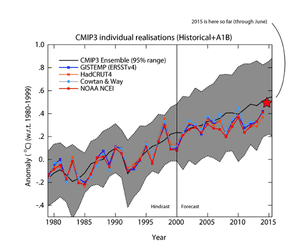Climate model global surface temperature projections have been quite accurate

In an earlier post, I wrote about some research that compared ocean temperature measurements to climate model predictions. It turns out, the models have done a great job estimating the increase in ocean heat although they have slightly under-predicted the change.
What about other components of the Earth’s climate? For instance, how have the models done at predicting the changes in air temperatures? With recent data now available, we can make an assessment. I communicated with NASA GISS director Dr. Gavin Schmidt, who provided the following data.
The graph shows the latest computer model simulations (from the CMIP project), which were used as input to the IPCC, along with five different temperature datasets. The comparison to be made is of the heavy dashed line (annotated in the graph just below the solid black line) and the colored lines. The heavy dashed line is the average predicted temperature including updated influences from a decrease in solar energy, human emitted heat-reflecting particles, and volcanic effects.
The dashed line is slightly above the colored markers in recent years, but the results are quite close. Furthermore, this year’s temperature to date is running hotter than 2014. To date, 2015 is almost exactly at the predicted mean value from the models. Importantly, the measured temperatures are well within the spread of the model predictions.

If we next consider earlier predictions using the prior generation of climate models, we see results below. Again, we see that in recent years, temperatures are slightly below the average of the models, but well within the uncertainty range. Furthermore, if we were to add the current 2015 temperatures, it would be very nearly at the model mean.

So we see the models are doing a pretty good job. Certainly, they are good enough for us to project out into the future. I think of models as a crystal ball. We use them to see the future, albeit as a cloudy picture. While we cannot expect models to be perfect, they are good enough to help inform our decisions today.
Advertisement
A very good update on models is published in the US CLIVAR summer letter, available here. Gavin Schmidt’s article is pages 25-29. The lead author, Kate Marvel and colleagues investigated various reasons behind changes to the rate of surface temperature increases since 1998. They look at biases in observations, errors in model forcing, uncertainties in trends due to the short time period and they also recommend steps to move forward by focusing on seasonal or regional aspects of climate change. It is a freely available report and a short clear read.
Kate’s article doesn’t try to show that computer model predictions are necessarily compatible with observations. Their main point is to show that “compatible” is ill-defined and that differences between models and observations can arise from many different sources, none of which we can differentiate by looking at short-term global mean trends.

